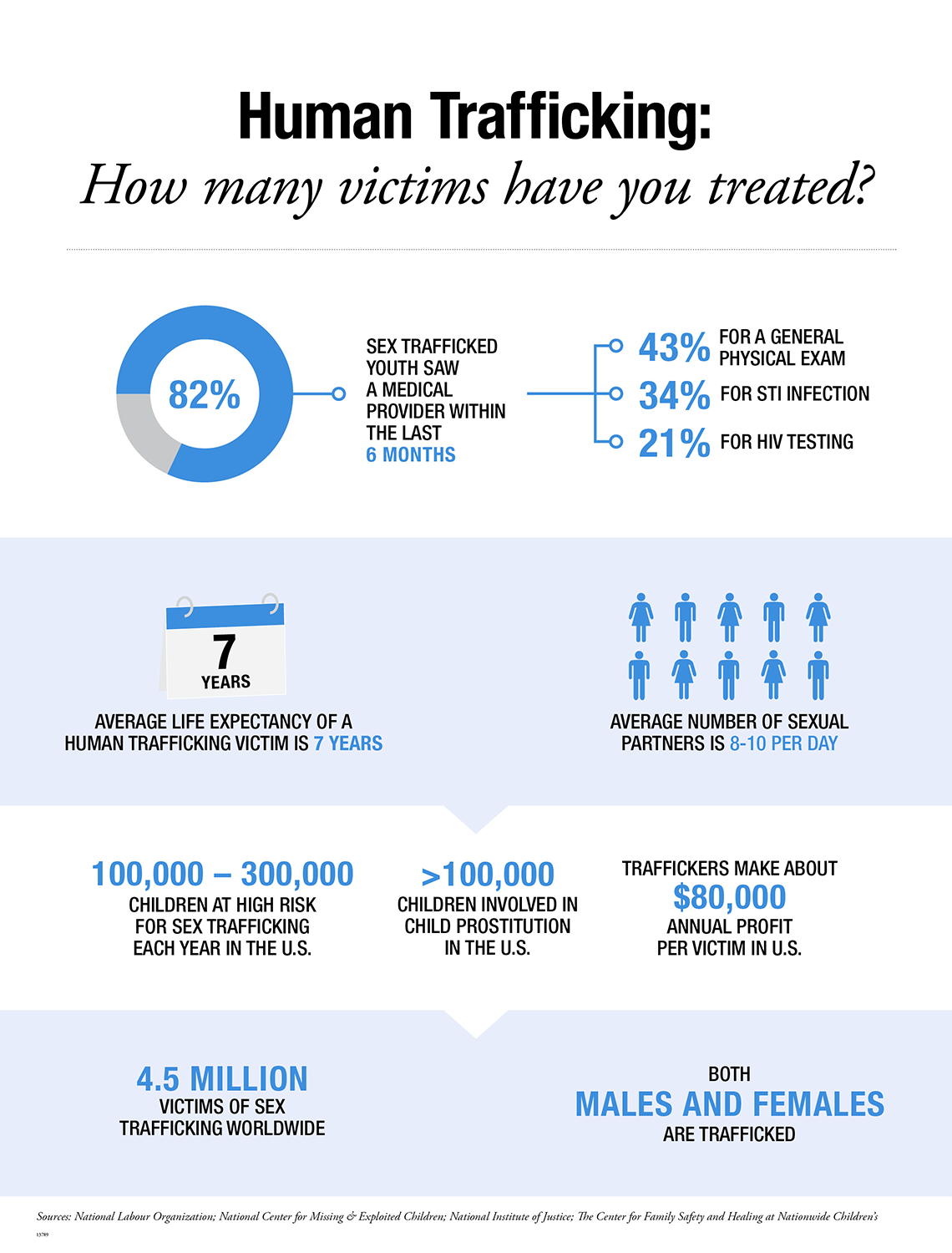Human Trafficking: How many victims have you treated?
Human Trafficking: How many victims have you treated? https://pediatricsnationwide.org/wp-content/uploads/2017/03/AdobeStock_104049456_HRBW-header-1024x575.gif 1024 575 Abbie Miller Abbie Miller https://pediatricsnationwide.org/wp-content/uploads/2023/05/051023BT016-Abbie-Crop.jpg- March 22, 2017
- Abbie Miller

Data shows that health care providers may be coming into contact with victims and those at risk with more frequency than expected.
How many victims have you treated? The answer is probably higher than you think. According to a report published in the Annals of Health Law, 88 percent of sex trafficking survivors reported contact with a medical provider during the period of exploitation.

How does this happen?
How do providers come into contact with these victims and not know it? (Let’s just assume that if a provider knew their patient was a sex trafficking victim that they would intervene.)
According to Megan Letson, MD, MEd, division chief of Child and Family Advocacy at Nationwide Children’s Hospital, the answer is both simple and complex. First, these victims do not identify themselves as victims. Many of these children and young adults come from situations that they believe to be worse than being used or sold for sex. They may fear or “love” their captor. They have been taught, either through experience or conditioning by the captor, to distrust authority. And finally, they may feel shame.
Victims of sex trafficking have been conditioned through some combination of the following methods: starvation, confinement, beatings, torture, rape or gang rape, threats of violence to victim and victim’s family, forced drug usage, cultural beliefs such as karma and denial of medical care or medications. They may be experiencing trauma bonding or even Stockholm syndrome. According to Dr. Judith Herman in Trauma and Recovery, the goal of the perpetrator is to instill in his victim not only fear of death but also gratitude for being allowed to live.
The victim typically presents with the trafficker, who identifies himself or herself as family or a trusted family friend. Often, in cases of adolescent females, the trafficker will present himself as her boyfriend.
“If you don’t know what to look for, it can be very easy to miss the signs,” says Dr. Letson. “The most important thing a provider can do is get educated about the risk factors and warning signs.”
Risk factors for sex trafficking victimization:
- History of abuse or neglect
- Caregiver substance abuse or criminality
- Exposure to intimate partner violence
- Gang affiliation
- Sexual minority status
- Poverty
- Substance abuse
- Behavioral problems/mental illness
Possible indicators that a person is a victim of human sex trafficking:
- Hotel room keys
- No identification or a fake ID
- Unable to provide address
- Lying about age
- Numerous school absences
- Dating much older, abusive or controlling men
- Large amounts of cash, jewelry or new clothes
- Recurrent STIs and/or need for STI and pregnancy tests
- Unwanted pregnancies
- Signs of physical assault or unexplained injuries (branding or tattooing, fractures, bruising, black eyes)
- Runaway or homeless
“Runaway and homeless youth are extremely high risk,” says Dr. Letson. “They are lured by promises of emotional, economic and domestic stability. And they are likely to be invited to participate in the commercial sex industry within 48 hours of being on the street.”
Additionally, she notes that 74 percent of runaways who become victims were in the care of social services or foster care when they went missing.
What should you do if you suspect trafficking?
Separate the suspected victim from the accompanying person. Depending on the situation, Dr. Letson suggests telling the person that a private medical examination is standard practice, taking the patient to another department (radiology, for example) or asking them to step outside to answer questions about paperwork.
When you can question the suspected victim alone, how you ask the questions is critical to whether or not you will get truthful answers.
“Be nonjudgmental, calm and open minded,” says Dr. Letson. “Convey a desire to provide assistance and foster trust.”
Example questions to ask a suspected victim:
- Have you ever been forced to do something you don’t want to do?
- Has anyone ever asked you to have sex in exchange for something you wanted or needed?
- Has anyone ever asked you to have sex with another person?
- Has anyone ever taken sexual pictures of you or posted such pictures on the internet?
“Always be prepared that the victim may not be honest with you,” warns Dr. Letson. “If they don’t identify as a victim, if they are too afraid, they may not open up to you. But by reaching out and building trust, you may open the door for them to ask for help later.”
What should you look for in an exam of a victim or suspected victim?
Beyond the reason for the visit, providers should look for signs of injury including: traumatic brain injury, concussions, fractures, burns, bruising, bite marks and ano-genital injuries. During the comprehensive exam, the provider should also be aware of exposure to STIs, pregnancies, abortions, malnutrition, dental neglect, alcohol or drug use and suicidality.
“If you identify that your patient is a victim of sex trafficking, have a response plan in place for your office,” says Dr. Letson. “The plan should include separating the child from others, the initial screening and medical exam. You will need to report to Children Services and law enforcement while the patient is still in the office. They can assist in determining next steps, which may include referral to a child advocacy center for a forensic interview and medical exam or referral to the emergency department for an acute evaluation.” It is important to discuss a safe discharge plan with Children Services.
Acute needs of victims:
- Food, shelter and clothing
- Emotional support
- Medical attention for acute and chronic problems
- Psychological assessment and trauma-informed therapy
- Dental care
- Life skills and job training
- Language assistance
- Immigration assistance
- Family services and potential reunification
- Transition services after intensive intervention
- Victim advocacy during criminal investigation
- Substance abuse rehabilitation
- Transportation
- Protection
- Victim’s compensation
- Child care
Learning what resources are available in your community is an important part of identifying and helping victims and at-risk patients, says Dr. Letson. Connecting the victim to appropriate community and mental health resources is vital to their recovery. Long term health concerns for victims include injury, disease, substance abuse, somatization, PTSD, depression, anxiety, suicidality, homicidality and aggression, according to an article published in Current Problems in Pediatric Adolescent Health Care.
What resources are available?
In central Ohio, the Child Assessment Center in the Center for Family Safety and Healing at Nationwide Children’s Hospital offers responsive and timely support for child/adolescent victims of human trafficking. Team members are available to do medical assessments and forensic interviews as well as provide a connection to community-based human trafficking response networks.
Additional Resources
Center for Family Safety and Healing
Gracehaven Central Ohio Youth for Christ
The Salvation Army’s Anti-Human Trafficking Program (National)
Mount Carmel Crime & Trauma Assistance Program (Central Ohio)
National Human Trafficking Hotline 888-3737-888
Polaris Project (National)
References:
- Lederer LJ, et al. The health consequences of sex trafficking and their implications for identifying victims in healthcare facilities. Annals of Health Law. 2014.
- Letson, M. Grand Rounds Presentation at Nationwide Children’s Hospital, Columbus, Ohio. 12 Jan 2017.
- Herman, J. Trauma and Recovery: The Aftermath of Violence — From Domestic Abuse to Political Terror. Basic Books: New York. 1997.
- Greenbaum J. Commercial sexual exploitation and sex trafficking of children in the United States. Current Problems in Pediatric Adolescent Health Care. 2014;44:245-269.
Photo credit: Adobe Stock
Infographic: Nationwide Children’s
About the author
Abbie (Roth) Miller, MWC, is a passionate communicator of science. As the manager, medical and science content, at Nationwide Children’s Hospital, she shares stories about innovative research and discovery with audiences ranging from parents to preeminent researchers and leaders. Before coming to Nationwide Children’s, Abbie used her communication skills to engage audiences with a wide variety of science topics. She is a Medical Writer Certified®, credentialed by the American Medical Writers Association.
-
Abbie Millerhttps://pediatricsnationwide.org/author/abbie-miller/
-
Abbie Millerhttps://pediatricsnationwide.org/author/abbie-miller/
-
Abbie Millerhttps://pediatricsnationwide.org/author/abbie-miller/
-
Abbie Millerhttps://pediatricsnationwide.org/author/abbie-miller/
- Posted In:
- Features







